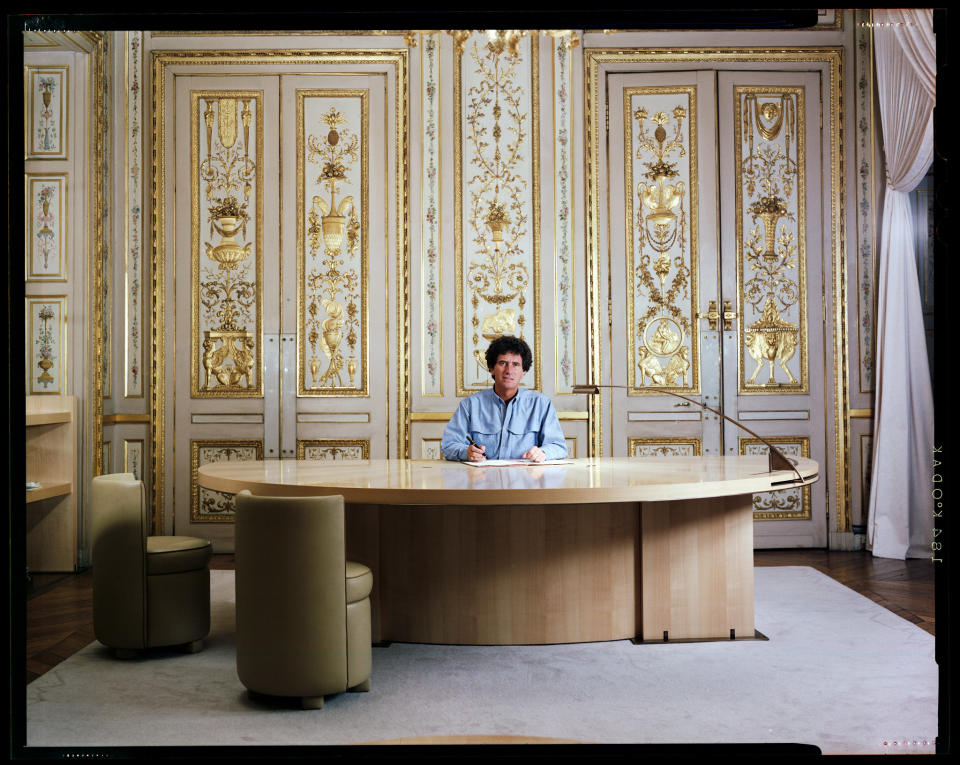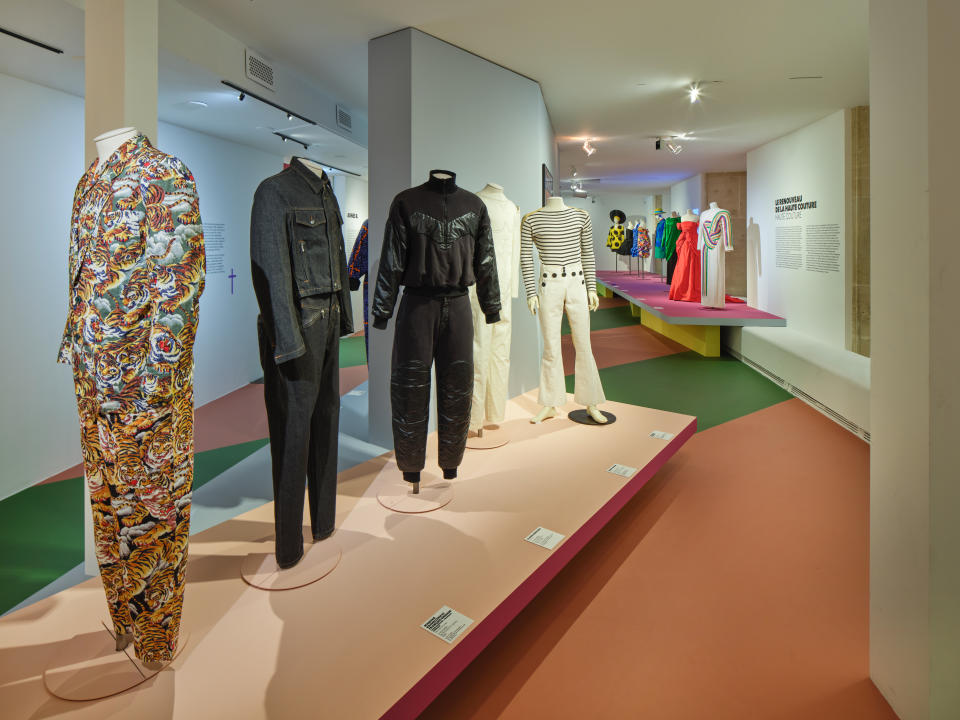Les Arts Décoratifs Celebrates France’s Eclectic ’80s in New Exhibition
- Oops!Something went wrong.Please try again later.
- Oops!Something went wrong.Please try again later.
- Oops!Something went wrong.Please try again later.
- Oops!Something went wrong.Please try again later.

PARIS — If broad shoulders, brash hues and shaggy hairdos are visual cues of the 1980s, for French people that decade was all about the arrival of a left-wing administration, tongue-in-cheek advertising and a tidal wave of groundbreaking fashion and design superstars.
That’s the impression left by “Années 80, Mode, design et graphisme en France,” an exhibition at Les Arts Décoratifs that dives into a period that “signs the arrival of eclecticism, when the diktat of ‘a style’ faded in favor of people going towards what attracted them, something that is still prevalent today,” explains the museum’s new director Christine Macel.
More from WWD
Paris Exhibition Explores How Frida Kahlo Constructed Her Identity Through Clothing
A Look at 'Fashioning America: Grit to Glamour' Exhibition to Bow in Bentonville
Curated by Amélie Gastaut, Karine Lacquemant, Mathilde Le Corre and Sébastien Quéquet, the exhibition — and decade — opens with a campaign poster for the 1981 French presidential election that saw left-wing politician François Mitterrand begin his 14-year run as the country’s longest-serving president.
The first of three sections, this gallery explores marketing as the bedrock of anything from politics to the fight against AIDS, the liberalization of audiovisual communication as well as the influence of the incoming administration.
“The 1980s are about humor, lightness that isn’t superficial but on the contrary, a way of life — a form of blue-sky thinking,” she continues.

On a circular plinth and looking into the central nave is the collarless Thierry Mugler suit designed for then-culture minister Jack Lang, who was famously booed for wearing this radical departure from conventional suits at the French National Assembly.
The retired politician, who on Thursday was examining exhibits with obvious relish and later congratulated the four curators on the “marvelous result,” is a pivotal figure of the decade.
Cocurator Amélie Gastaut explains the cultural policies pursued by France’s incoming socialist government and the minister of culture had contributed to breaking down boundaries between fields, especially fine and applied arts — and the creation of the advertising and fashion museums that have now been folded under the umbrella of the Musée des Arts Décoratifs.
She gives the example of advertising, where “investment grew 380 percent” and created a golden age despite initial fears.
Image-making segues into a second section, occupying the central nave and dedicated to design.
“To understand design in those years, you have to understand it was a great desert,” says design-focused cocurator Lacquemant, explaining that industrialists strayed toward utmost caution while Ikea also emerged as a force of blandness.
Among those pushing forward were the French presidential couple, François and Danielle Mitterrand, commissioning then-rising stars of interior architecture and design to revamp the private apartments of the Élysée Palace and their offices.
Other initiatives public and private followed suit, resulting in the emergence of signatures like Philippe Starck or Martin Szekely by helping them industrialize and promote their work internationally.
Fashion silhouettes introduced the exhibition’s overarching idea of “carambolage,” or pile-up, that saw boundaries become porous between disciplines with filmmakers dabbling in advertising, couturiers becoming scenographers and architects turning into bag designers.
“There isn’t really a school [of thought] and that’s perhaps what makes the singularity of this time,” she continues, noting that the parallel emergence elsewhere of the Memphis Group egged France’s creative class to be even more free in their designs.

The palpable effervescence of the scene has “never been lost [since],” remarks Jean-Charles de Castelbajac, now a veteran of the industry but then one of those fizzy new signatures. Two of his color-blocked looks rub elbows with a black 1981 Comme des Garçons jumpsuit in the exhibit.
Elsewhere, there are a curvaceous leather ensemble from Azzedine Alaïa, who collected Szekely’s work and asked him to create the scenography for the 2013 retrospective; Issey Miyake’s pleated separates; Jean Paul Gaultier’s exuberant costumes for performers; examples of Christian Lacroix couture designs, and Vivienne Westwood’s pirate looks.
Passing through a section on nightlife, and the emergence of clubs such as the Palace, leads to a gallery on fashion which embedded itself into cultural institutions and popular culture at the same time during this decade of “cash and flash.”
The gallery offers a kaleidoscopic view of the spectrum of fashion then, ranging from Karl Lagerfeld’s neoclassical designs at Chloé; the ’40s-inflected looks of Thierry Mugler and Claude Montana; Gaultier’s sailor look; Agnès b.’s basics, and even the premises of accessible fashion with designer collaborations – Miyake, Sonia Rykiel, Gaultier among them — with mail-order retailer Les 3 Suisses.
Haute couture follows, with silhouettes from Lagerfeld’s early days at Chanel standing next to Hubert de Givenchy’s ladylike creations and Yves Saint Laurent’s power woman.

Closing the exhibition are two seminal moments of 1989, the fall of the Berlin Wall and France’s July 14 parade, celebrating the bicentenary of the French Revolution and choreographed by French artist Jean-Paul Goude. Broadcast live, it was watched by some 800 million viewers across the world, in addition to the nearly 1 million people who lined up along the avenue and adjoining streets.
The three-hour long procession on the Champs-Elysées, which culminated with American opera singer Jessye Norman performing the “Marseillaise” draped in a French flag, was described by media at the time as “fantastic, baroque, grandiose” for its featured tableaux that ranged from regional music and dress to a Soviet tableau presented under artificial snow and even an evocation of that year’s disputed June 4 student movement in China.
“What’s interesting is the resilience of those years,” notes Macel, pointing out the world was barely emerging from the ’70s energy crisis when the Chernobyl nuclear disaster, mass unemployment and rampant inflation hit.
“It would be good for people to come here and understand not only the tools to resist [such a climate] but also that it’s about a state of mind and a way of facing the world — with humor, lightness and spirit,” she concludes.
“Années 80: Mode, design et graphisme en France” runs until April 16, 2023.
Best of WWD

